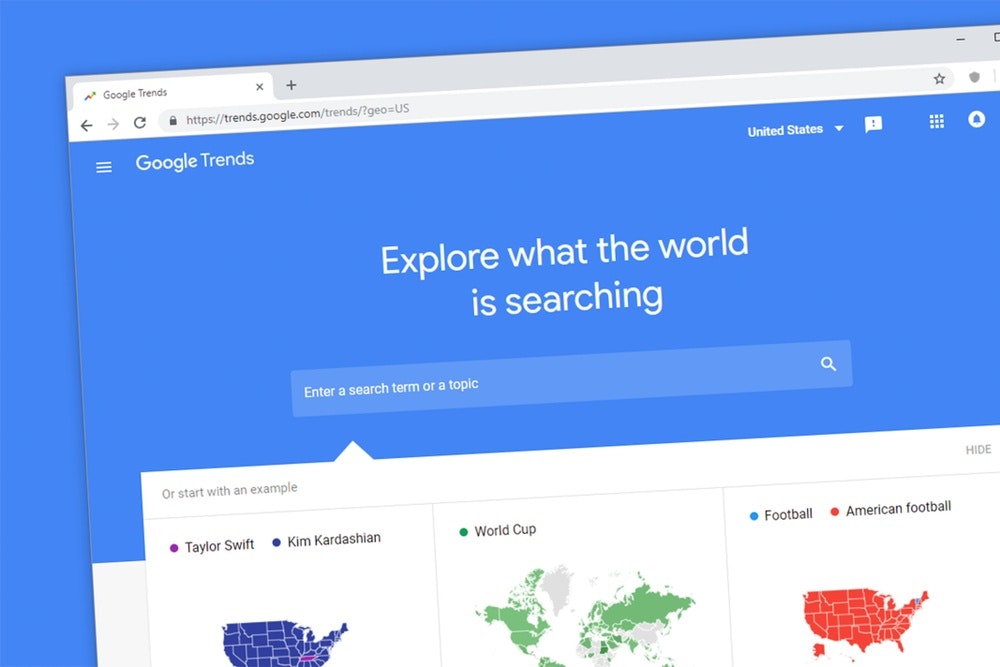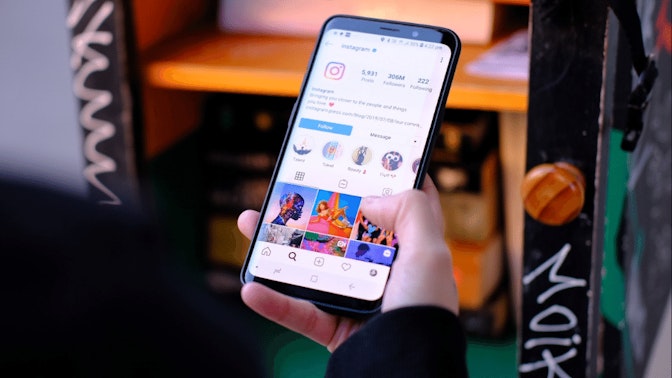Google Trends isn’t your average SEO tool. For those in ecommerce, it’s pretty handy at letting you know the seasonal trends of certain products—or your niche. You can even use it to edge out competitors by monitoring their positions.
In this article, we’ll present insights from three marketing professionals on how to best utilize Google Trends. Plus, discover use cases around leveraging Google Trends data to find untapped niches and seasonal trends.



What is Google Trends?
Google Trends is a free tool offered by Google that shows the popularity of search terms over time. You can use it to learn whether interest in a term is rising, stable, or declining. It also provides geographical and demographic insights, as well as related topics and queries. All this makes it invaluable for marketers, researchers, and anyone keen to understand shifts in consumer preferences.
How to use Google Trends according to three marketers
Jeff Moriarty, Mothers Family Rings:

Allison Schmidt, Marketing Manager of Get Online NOLA:

Cassidy Barney, SEO Manager of Epic Marketing:

10 Google Trends use cases for 2024
1. Using Google Trends to find niches
Google Trends is a great tool to find a skyrocketing niche. Whenever looking for a new niche, you’ll want to make sure you change your range from “Past 12 months” to “2004-present.” Doing this helps you see clearly whether the search volume is increasing or declining. But it also allows you to see seasonal trends in one clear-cut shot.
Here’s an example of a skyrocketing product in Google Trends: posture corrector.
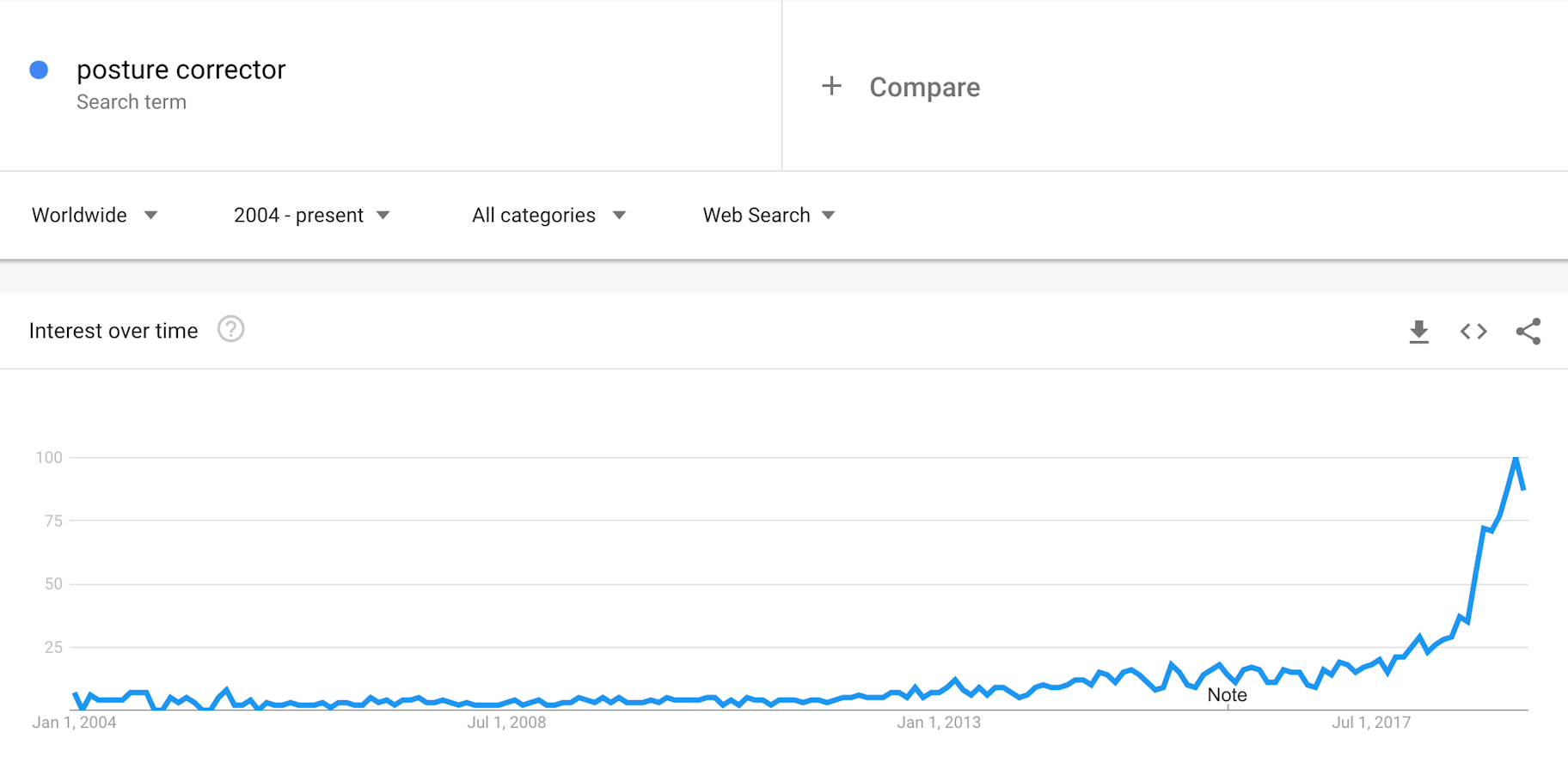
You can see quite clearly that over the past several months there’s been skyrocketing growth. In January we saw a sudden peak, with a slight dip in February. However, that doesn’t mean you can’t still capitalize on sales. So this trending product would need to be monitored for a while longer.
Here’s an example of a stable niche in Google Trends: iPhone.
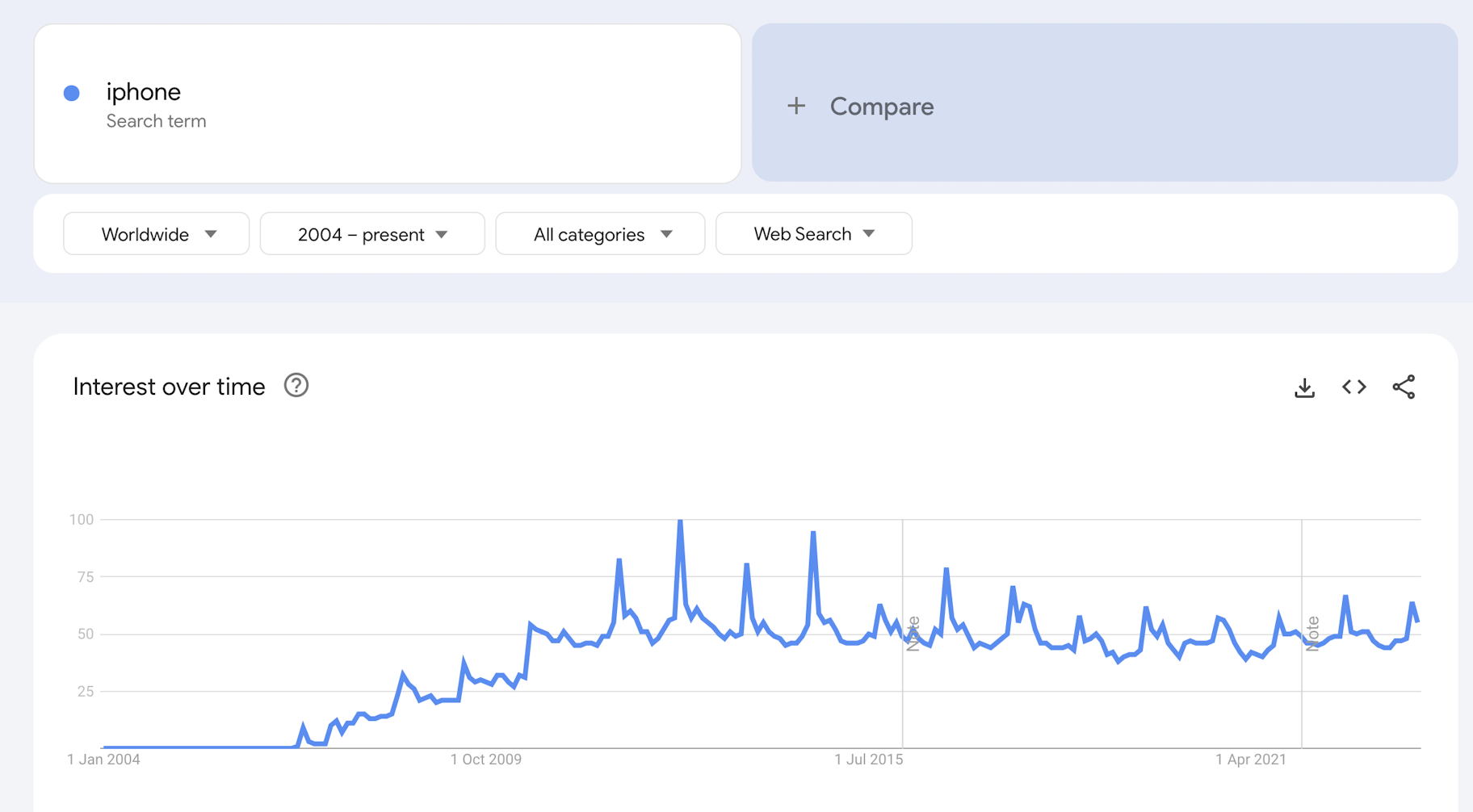
You can clearly see in the graph that there are slight dips. However, for the most part, the search volume for this niche is pretty stable. Over the span of several years you’ll see some slight dips or increases, which is normal. But for the most part, Google Trends shows that iPhone is a pretty stable niche.
You might be wondering what the dips and increases mean. Those show you the seasonal trends of the searches. August through October sees an increase in searches, with a decline starting in November. That doesn’t mean people don’t want an iPhone in November, it just means retailers might see a lower amount of website traffic at that time of year.
Wondering what a fad looks like on Google Trends? Well, you might want to check out this data on fidget spinners
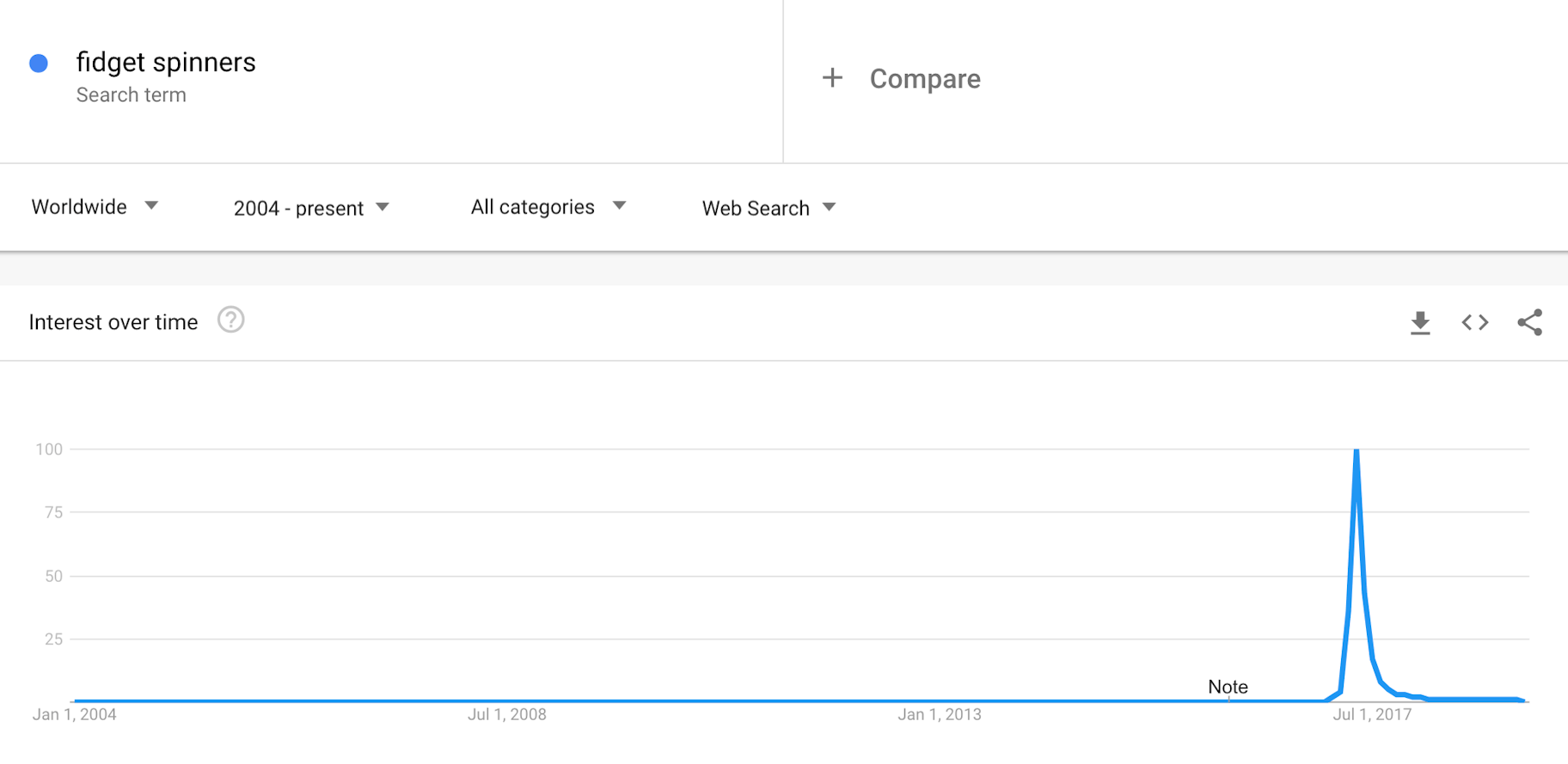
There were virtually zero searches for “fidget spinners” until February 2017. Three months later, in May, the product hit its peak. It’s pretty clear that there was a drastic and sharp increase in attention in those first few months. However, the sharp decline following the peak shows that this is no longer a good business idea to consider starting.
2. Find relevant product categories in ‘related topics’
Say you’ve created a niche store focusing on fake eyelashes. After owning your niche, you might be interested in expanding into other verticals. So instead of only selling fake eyelashes on your store, you want to sell other product categories that people may also be interested in.
After typing “fake eyelashes” into the Google Trends search bar, scroll down to the bottom where you’ll find “Related topics.”

What’s interesting is that two of the examples, “Nail” and “Eye shadow,” are a bit unrelated to fake eyelashes but could make sense as product categories on your store. A person who searches for or wears fake eyelashes is likely also interested in nail products or eye shadow.
So if you’re looking to expand the product collections on your store, checking out the related topics might be helpful. As for the adhesive, that product could also be sold on your store, as most fake eyelashes require eyelash glue.
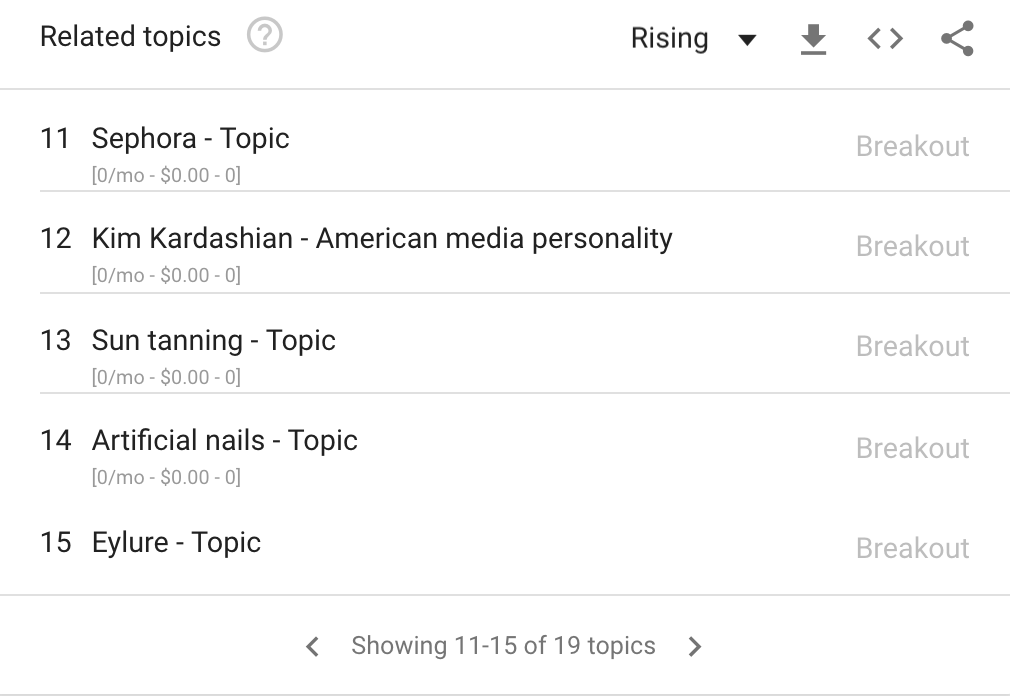
Keep in mind that, as you scroll through some of the related queries, you might find some don’t make sense for your business. For example, Kim Kardashian is listed as a Google Trends related topic for fake eyelashes. But, hey, you could always write a blog post about Kim Kardashian’s eyelashes.
3. Using Google Trends for keyword research
Suppose you’re selling women’s blouses on your store. By checking the Google Trends homepage, you notice that the Google search popularity for this term is trending upward, which is a good sign. But now you want to delve deeper into which keywords to target, how to name your product categories, and how to optimize a blog post about women’s blouses. A handy trick is to glance at the “Related queries” section, found to the right of the “Related topics” section we previously discussed.
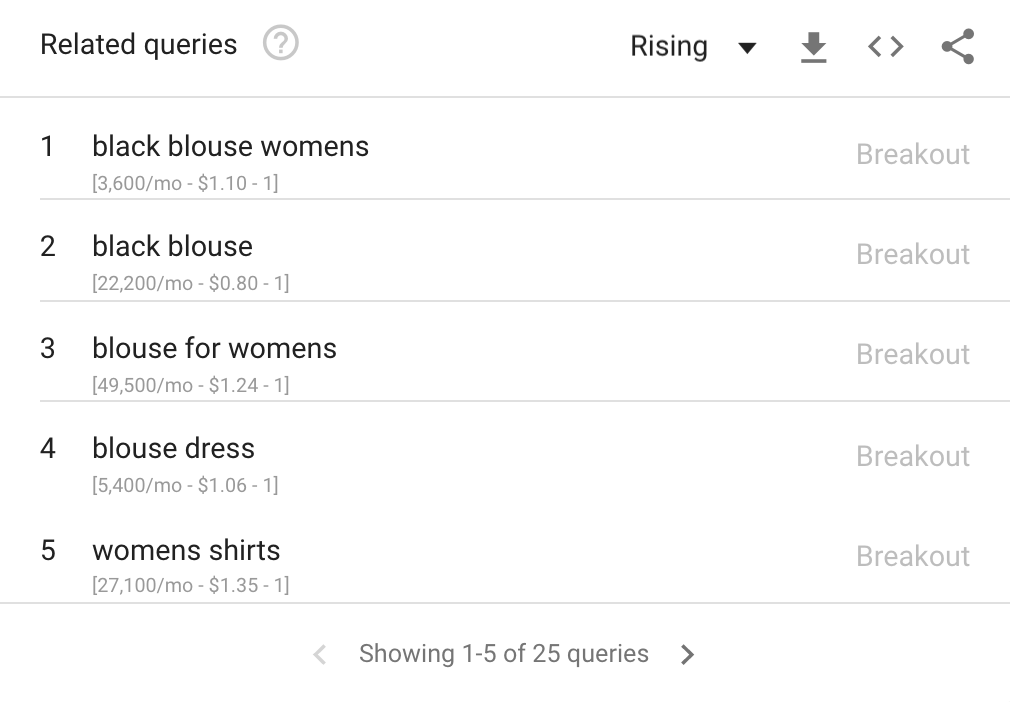
Throughout the 25 queries, you can consistently see a callout to color. In the graphic above you see two listings for the color black. On other pages, you’ll find white, blue, pink, and green. For these examples, you might choose to create a product category based on color such as “black blouses.” However, you can also include those keywords in your product page and in the name of the product. “Women’s shirts” or “blouses for women” could also be listed as a product category since they have search volume and make sense for this clothing type.
4. Using Google Trends data to identify seasonal trends
Seasonal trends play an important role in the success of your business. Throughout the year there’ll be peaks and dips that will impact your monthly sales. During peak season, competition and sales will increase in full force. During the dips, you might start selling seasonal products. Let’s break this down with a “summer” product: padded bikinis.
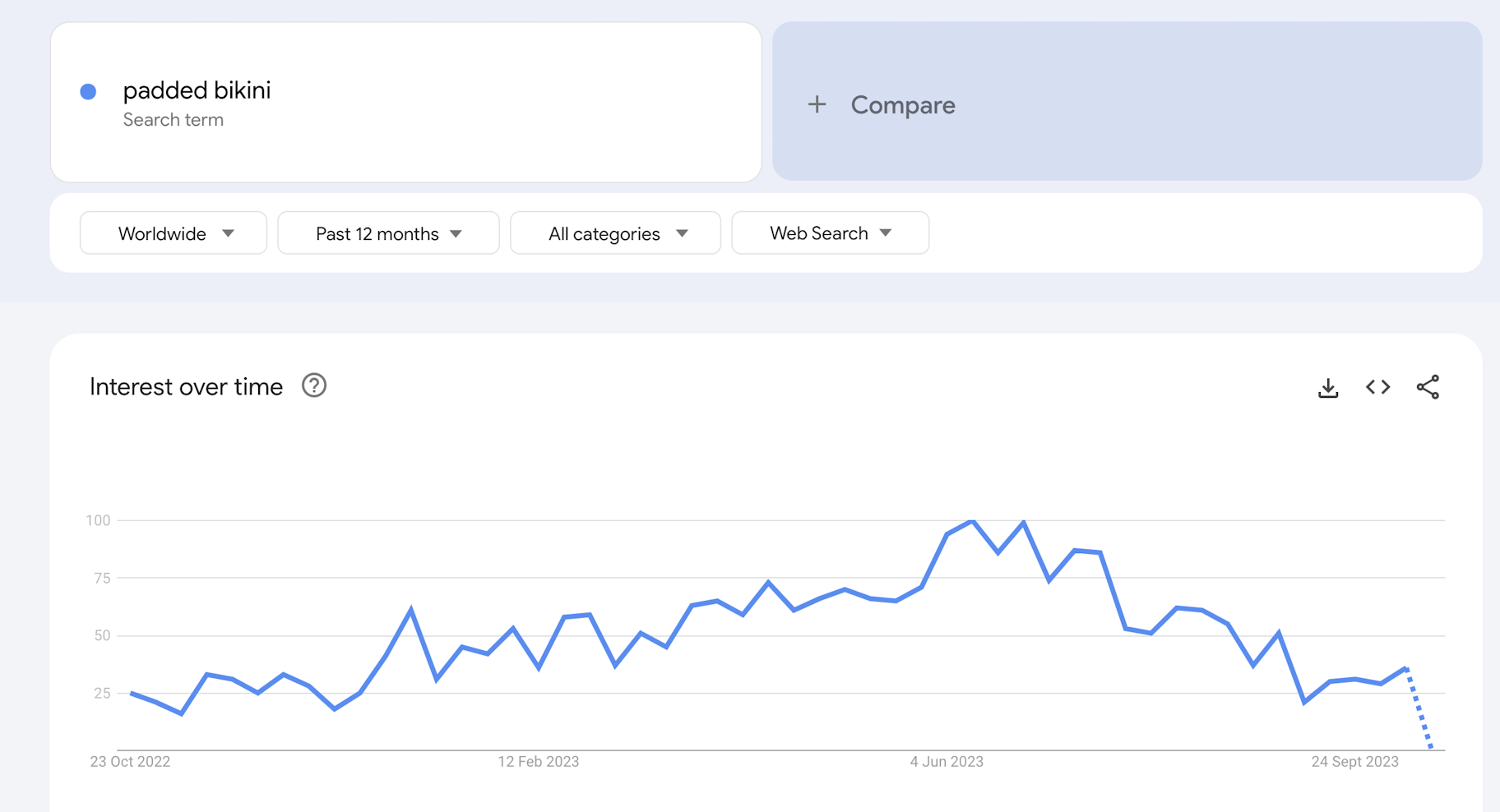
What’s interesting is that the data shows us that padded bikinis aren’t just for summer but for winter, too. The first peak of the year starts in January and continues to climb until June. Then there’s a drastic dip in September. Now, say it’s September and you decide to start a swimwear store, you might be feeling pretty discouraged about that dip. But that’s actually a great time to get started. It gives you a couple months to build your swimwear business so that when January rolls around you’re ready to go!
You might be wondering what to sell during the off season. Think of products that naturally complement the products on your store but would be a good match for the off season. Since swimwear is often sold by lingerie brands, selling pajamas might be an area to focus on during the winter months. Let’s take a look:
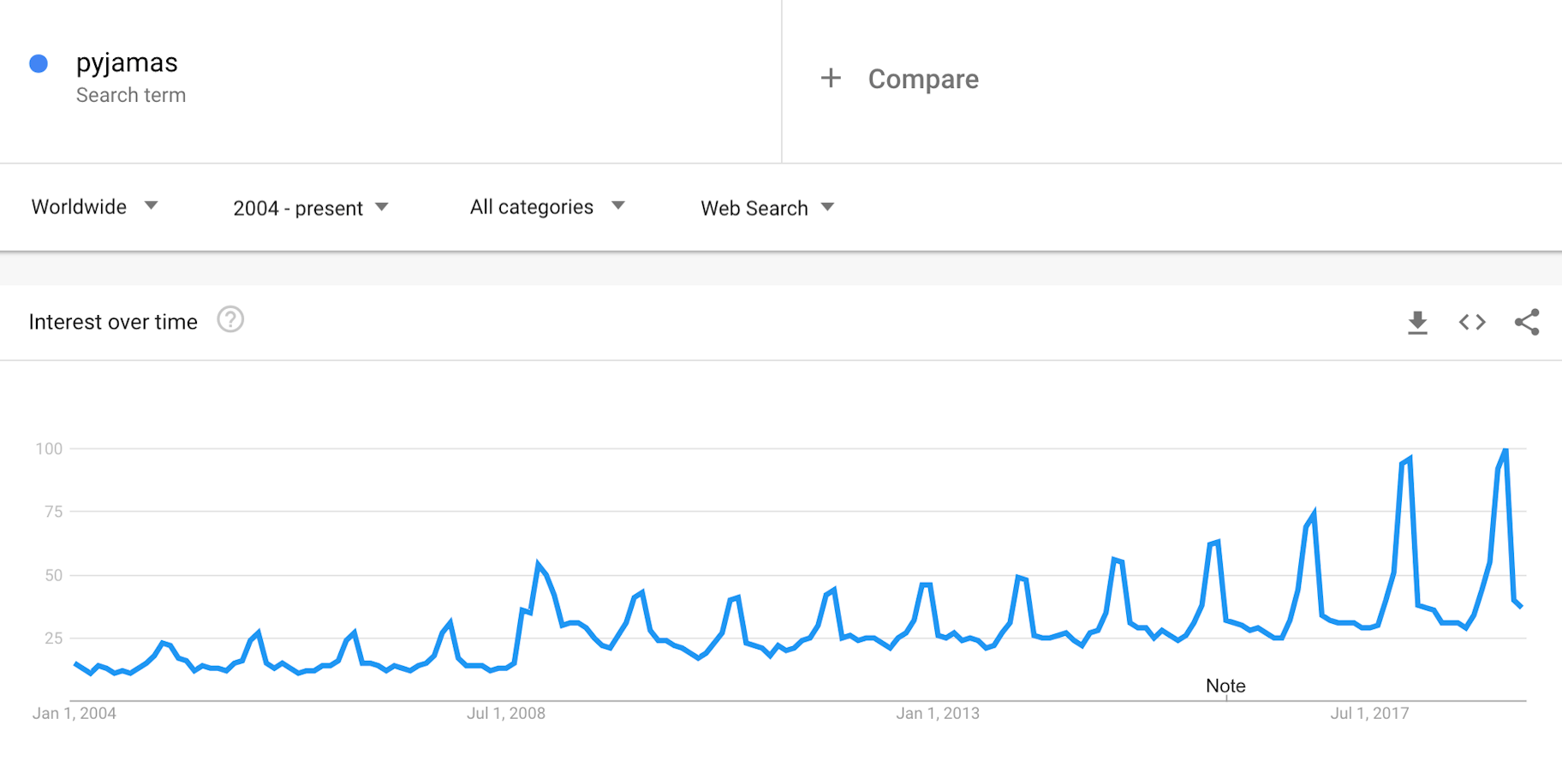
Between September to December, pajamas hit their peak, making it the ideal product to sell during the bikini off season by filling in the seasonal gaps.
5. Using Google Trends for content freshness
Content marketing is helping top online retailers own more traffic to increase brand awareness and to get more customers than ever before. So creating blog content for your website can help grow your business. One way to drive sudden spikes in search traffic is to do “content freshness.” What’s that? It’s when you remove outdated content, add fresh new details, and republish the content on your blog.
But where does Google Trends research come in? To illustrate, let’s revisit the concept of seasonality but with a twist. Imagine you own a cycling store with a blog article titled “How to fix a bike.” By inputting those keywords into Google Trends, you can observe specific search patterns. For instance, the research may indicate that the peak season for this search consistently falls in June and July each year.
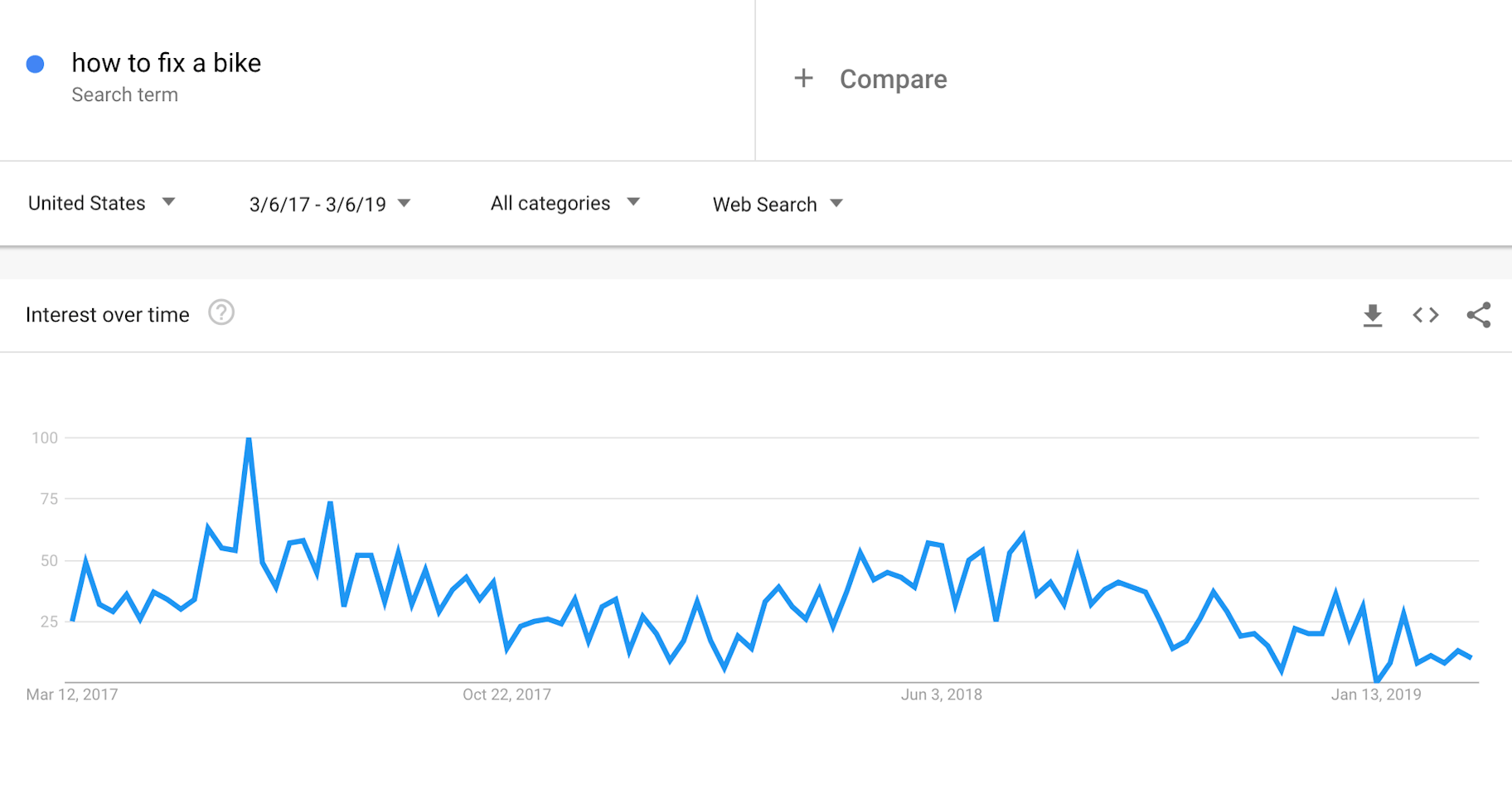
While it’s crucial to update content whenever your Google ranking dips, being proactive can enhance your strategy. By aligning your content freshness efforts with a search term’s peak season—using insights from Google trends research—you can gain an edge. For the cycling store owner, this might mean rejuvenating the “how to fix a bike” article at May’s end. Consequently, this timely update can catapult you to the pinnacle of search results for those keywords. Implement this strategy on your top-performing SEO articles, and watch your website traffic surge.
6. Create content around current trends
On the homepage of Google Trends, you’ll find a section for trending searches. Trending searches are the hottest topics of the moment. You can browse daily trending searches, real-time search trends, and search by country.
While most of the trending searches are regarding celebrity news, you will find some buzz-worthy stories that tie into certain niches. For example, on October 17, 2023, one of the most searched daily trends was regarding the “hottest pepper in the world,” which amassed more than one million searches.
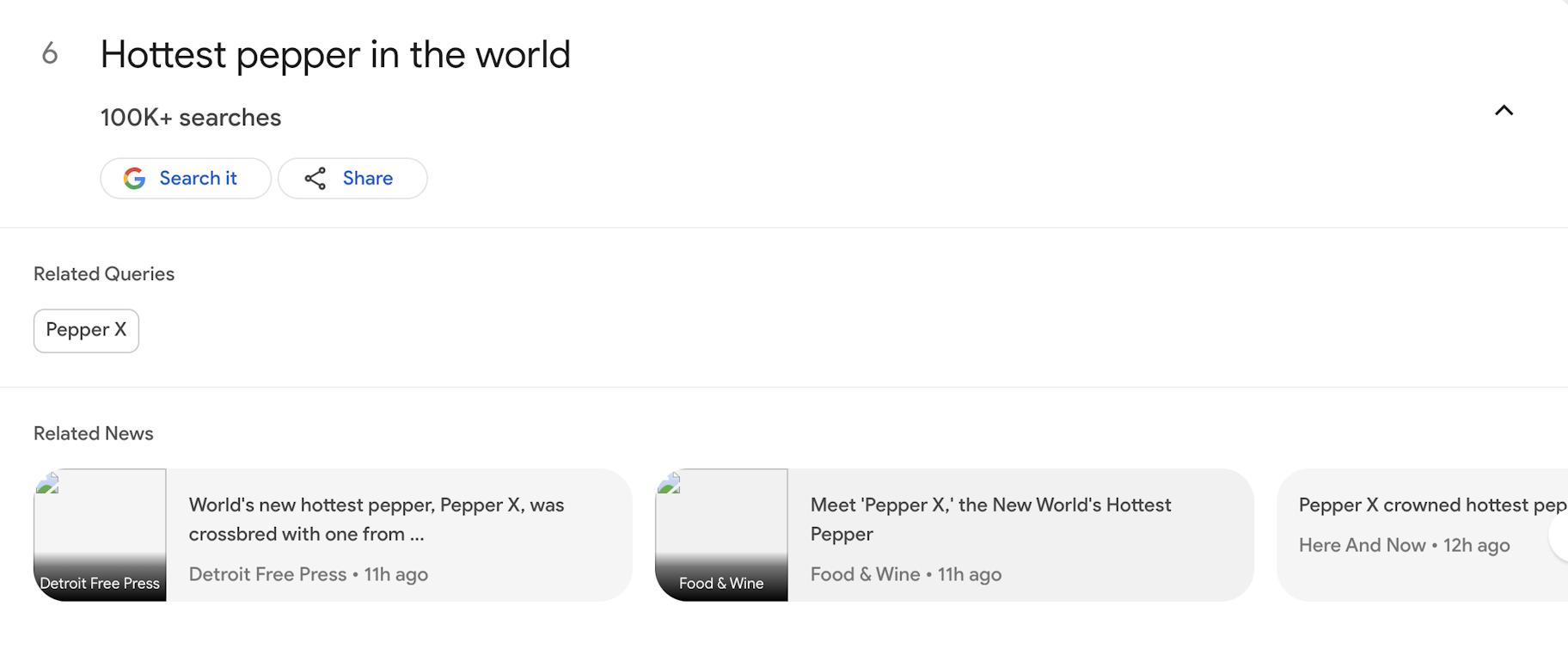
You can see categories like Food and Wine in the “Related news” section. If you own an online store that targets food enthusiasts, you could’ve written a newsworthy article on the topic on your blog.
By occasionally covering newsworthy stories on your store’s blog, you can drive high volumes of traffic back to your website. You can also jump on trending hashtags on X (formerly Twitter) to share your newsworthy article to get more followers and social media engagement.
7. Find niche topics by region
One of the most interesting elements of Google Trends is how you can find niche topics by region. When it comes to advertising, we often target an audience based on their country. With 334 million people in the United States alone, web search habits and interests can differ significantly across states. Surely the audience in New York isn’t the same as the audience in Louisiana. So let’s break down what these two states think about gold earrings.
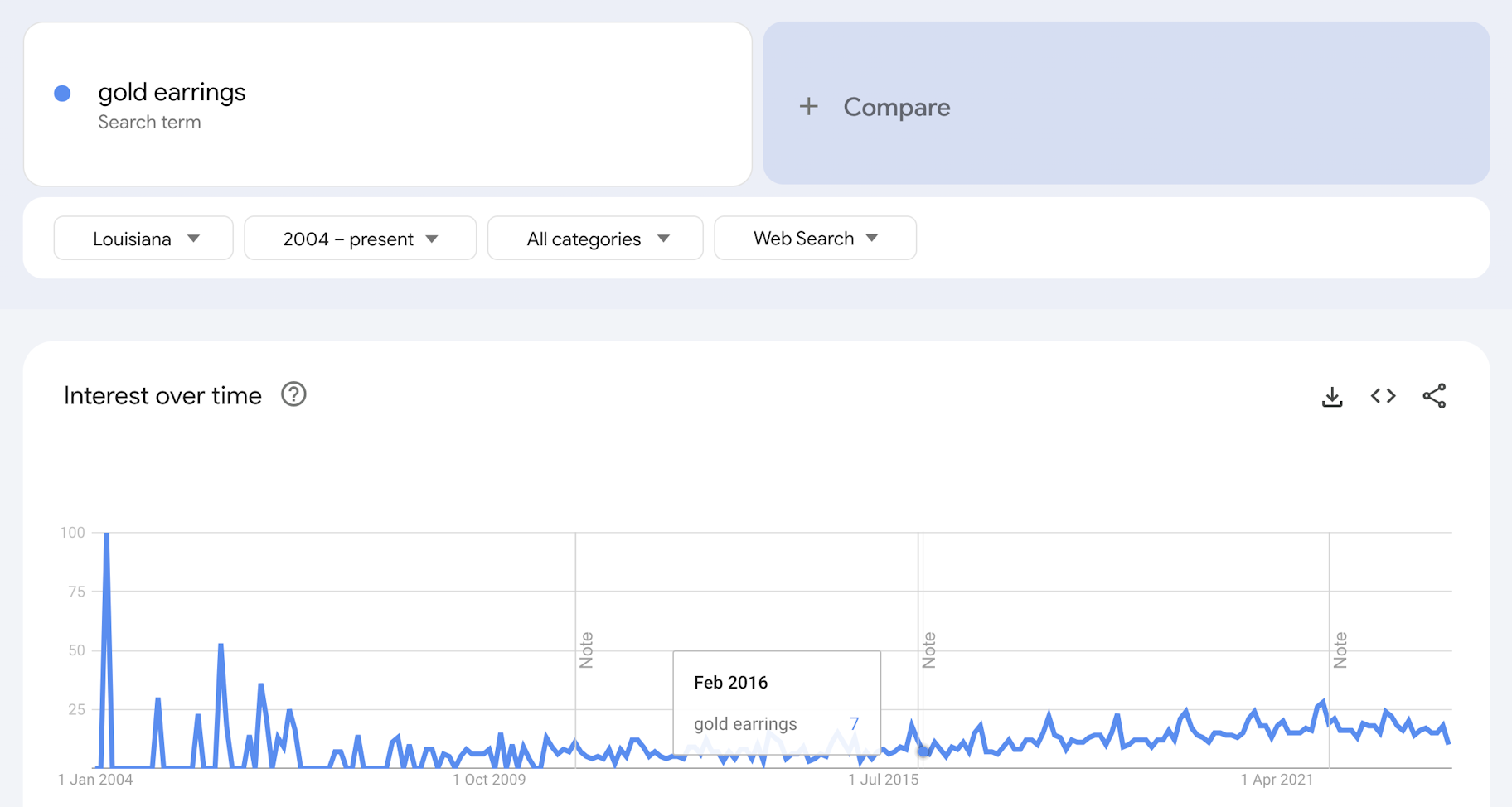
In Louisiana, interest in gold earrings isn’t very high. In November 2004, there was a sharp increase in search volume, but that level of interest has yet to return.
Now, let’s take a look at New York’s search interest on Google Trends.
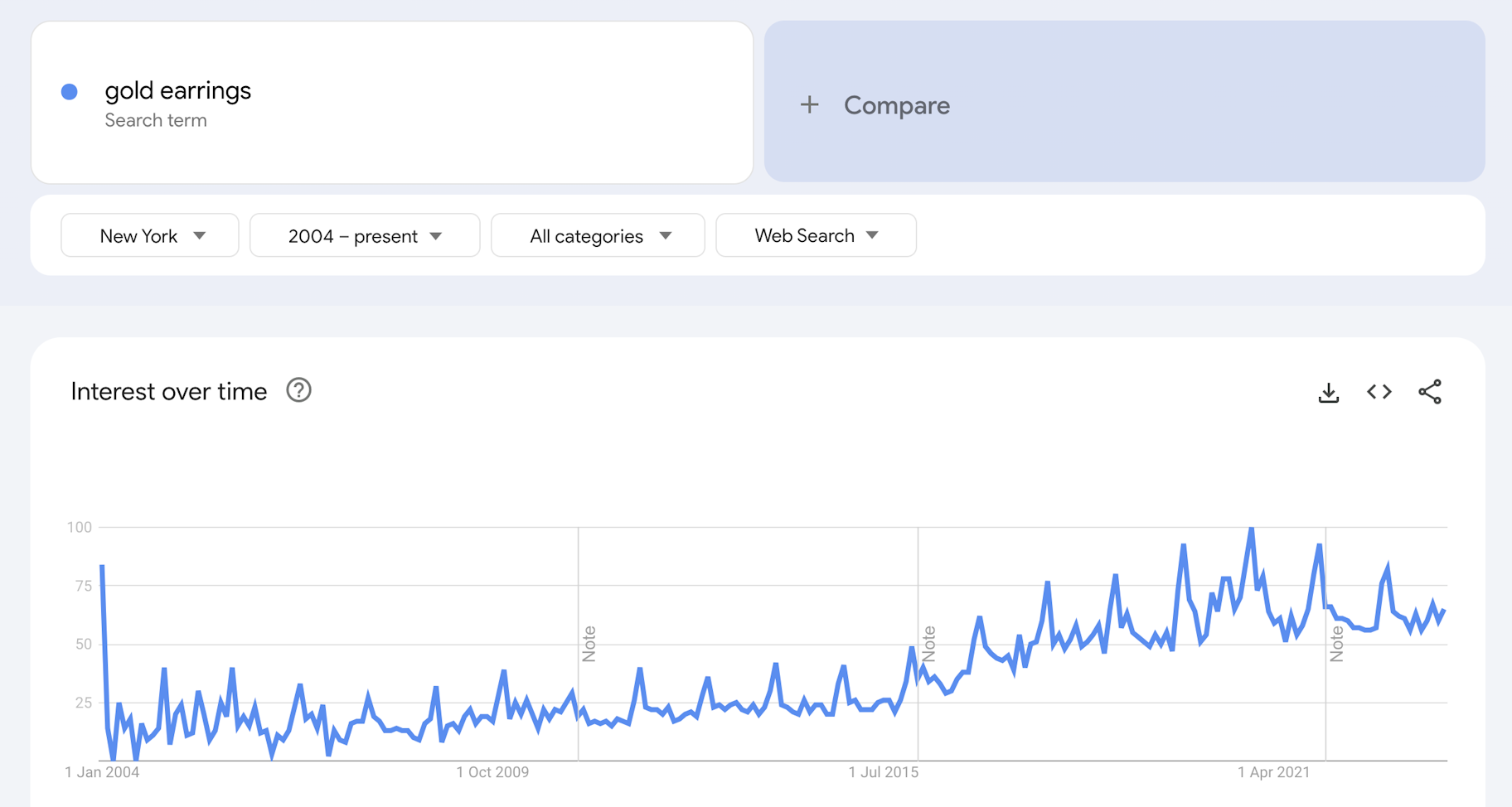
Right now, the search volume for “gold earrings” is on the rise in New York. So what does this mean? Well, if you create an ad for a pair of gold earrings that you’re selling, you’re better off targeting individual states like New York. Since there’s growing interest there, you’ll be able to capitalize on some sales, whether you promote it on Facebook or via Google Ads. You can cross-reference all the states to determine which ones have been seeing the trend rise. That way, you increase your chances of landing sales without wasting money by targeting places where interest is lagging.
8. Monitor Competitors’ Positions with Google Trends Compare
On Google Trends, you can even monitor your competitors and see how well they’re performing against your brand. With the Captain Marvel movie out, let’s do a Marvel Comics vs. DC Comics comparison to see how the brands have been performing over the years.
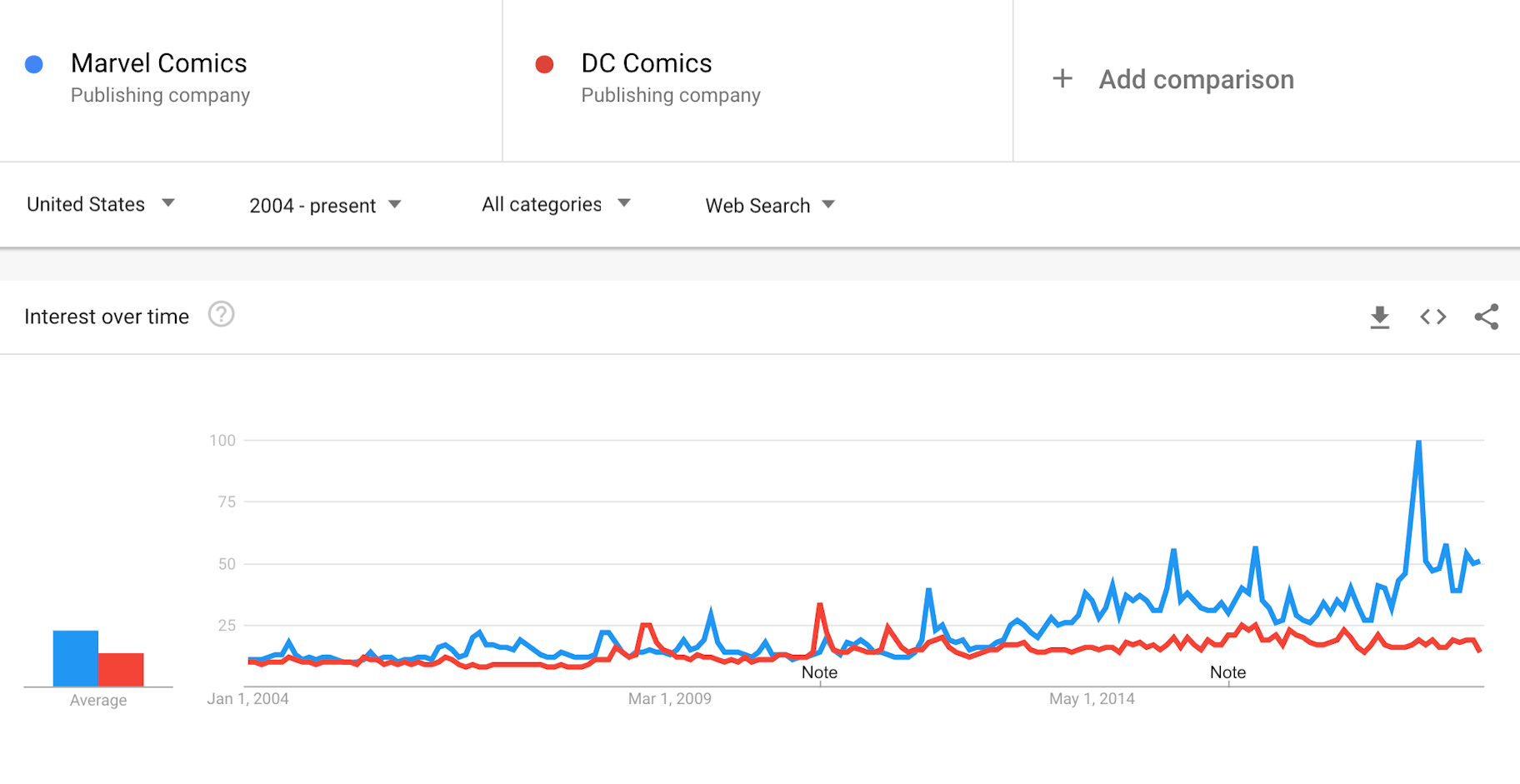
What’s interesting here is that in 2004, the two brands were performing at about the same level, with Marvel having a slight advantage. However, after 2013, we see the clear rise of Marvel coming out on top.
With this feature, you can compare up to five search terms or competitors. As your brand gains a bigger search audience, you can use Google Trends compare to ensure that you’re always a step ahead of competitors. And if you find that certain competitors are growing at a faster rate than you, you know to start analyzing their marketing channels to understand how you can improve.
9. Using Google Trends for YouTube content ideas
While Google Trends is typically used to improve your website’s performance, you can also use it to improve your reach in social media as well—in particular, YouTube. After heading to YouTube and searching for “fashion trends,” we noticed that the top videos used the keyword “fashion trends 2024.” So, let’s plug that into Google Trends and see what we get.
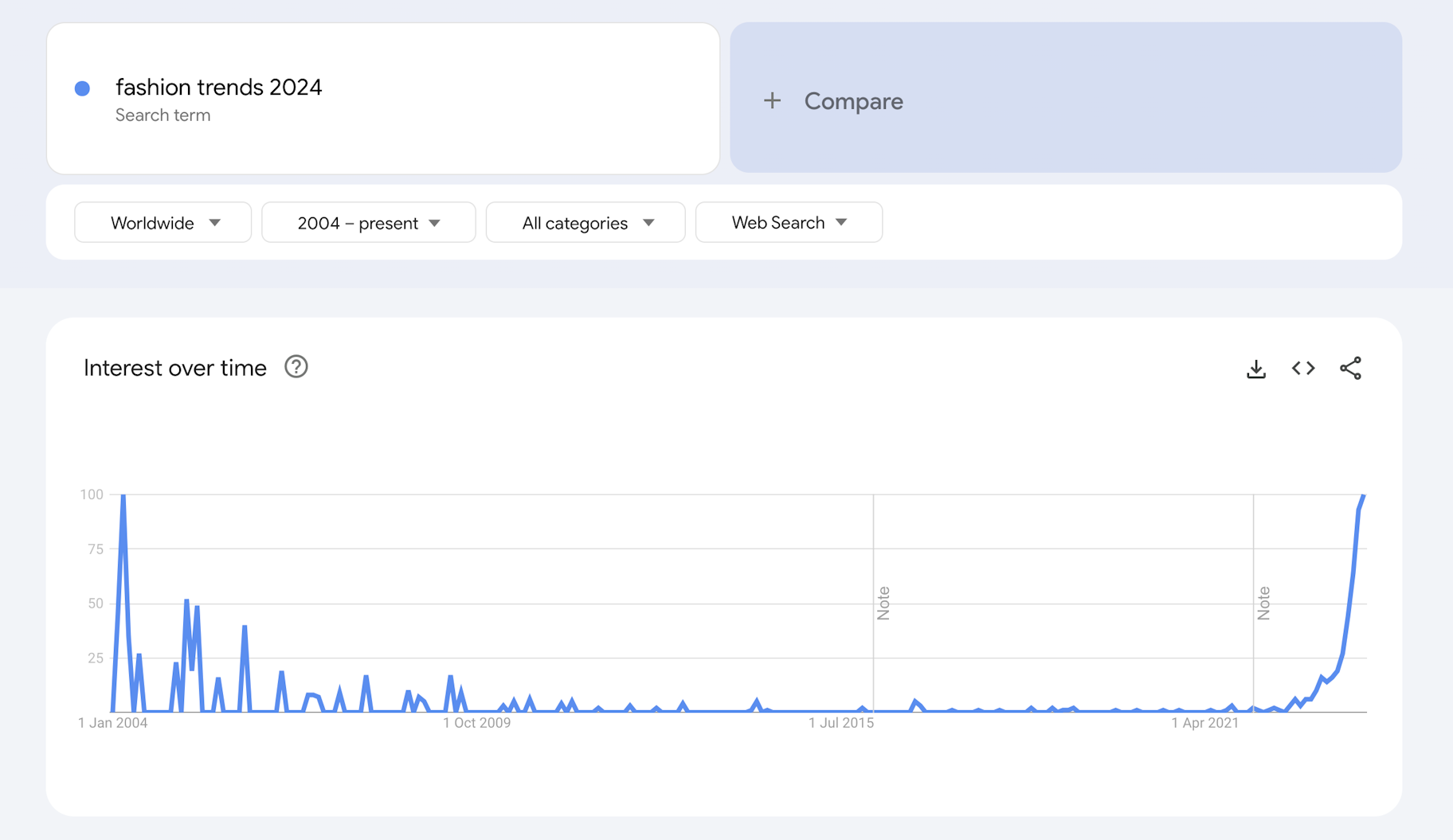
In recent weeks, this search term skyrocketed in interest. Of course, the year added to the keyword will make it a popular search term at the beginning of the year. However, after going back to YouTube and looking up “fashion trends 2024” in YouTube search, we noticed something interesting. Let’s take a look:

Each of the top videos were published in 2023. Why’s this interesting? Because oftentimes, vloggers (and bloggers, too) create content prior to the new year so they can get a head start on traffic.
So, if you plan to create a video centered around any trends in 2024, your best bet is to publish the video now to capitalize on the data you’d find in Google Trends.
Pro tip: If you have an email list, you might decide to send an email during March and September of 2024 to boost your video’s popularity again. Google will see that you’re promoting your older video content and may reward you with a higher position for your video so you can get even more views to it.
10. Optimizing Shopping ads with Google Trends data
You can also use Google Trends to help you determine the best time to create Google Shopping ads. Suppose you’re a fashion retailer trying to promote a brand new white dress on your store. By taking a look at the Google Trends’ Google Shopping feature, you can determine the best months for your ads:
Between February and June, there are high volumes of searches for white dresses in Google Shopping. Despite a small dip in August, the next two months, September and October, see a rise in Google Shopping searches. So, if you’re a retailer, you might start selling and promoting your white dresses between February and June and then again in September and October. Well, provided that you’re selling to an American audience, you’ll need to check the data for other countries if you plan to target outside the US.



Conclusion
From helping you plan ahead of seasonal trends to finding a rapidly growing niche, Google Trends can give you insights that will make your business a success. You’ll be able to find complementary verticals to expand your catalog and skyrocket your blog traffic by updating popular SEO posts just in time for peak season. By applying some of the Google Trends tips in this article, you’ll be a step ahead of the competition. This is your time to dominate, go get it!
Want to Learn More?
- 20 Ways to Use Google Calendar to Maximize Your Day
- How to Boost Traffic by Optimizing for Google’s Featured Snippets
- 23 Google Chrome Extensions You Need to Use
- 10 Google Search Statistics You Need to Know
